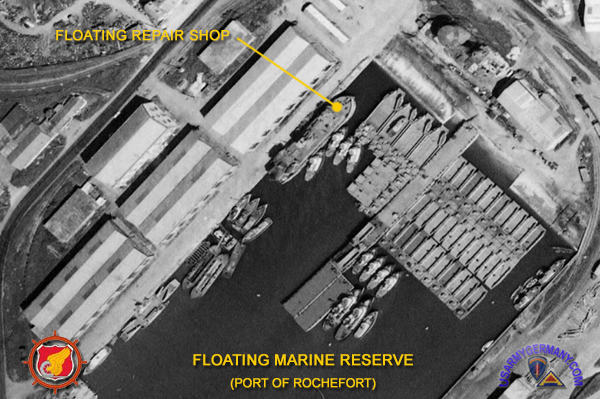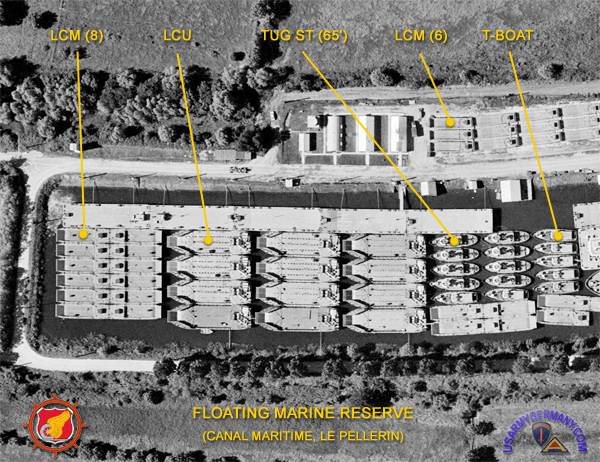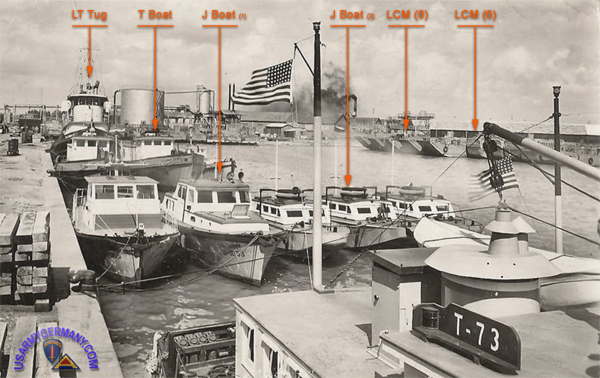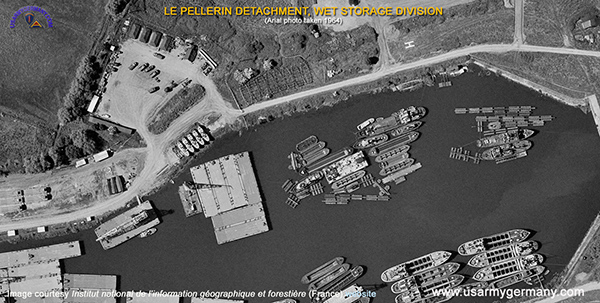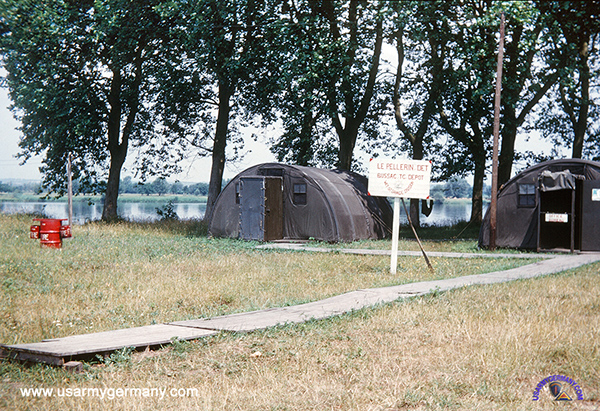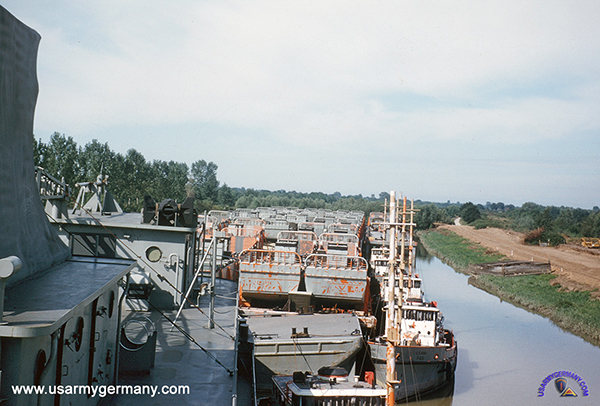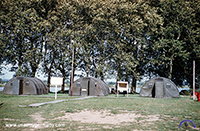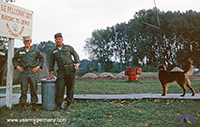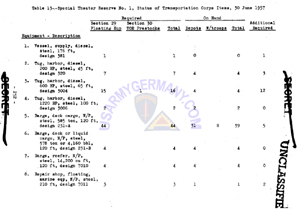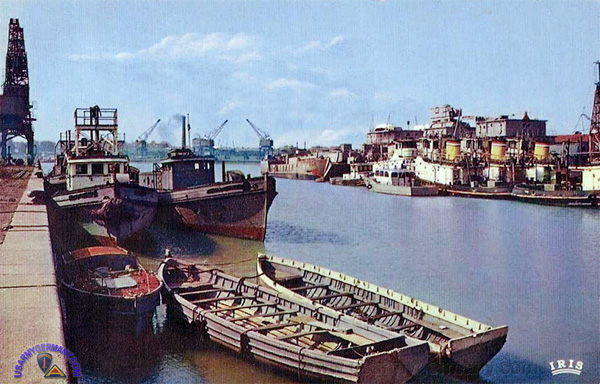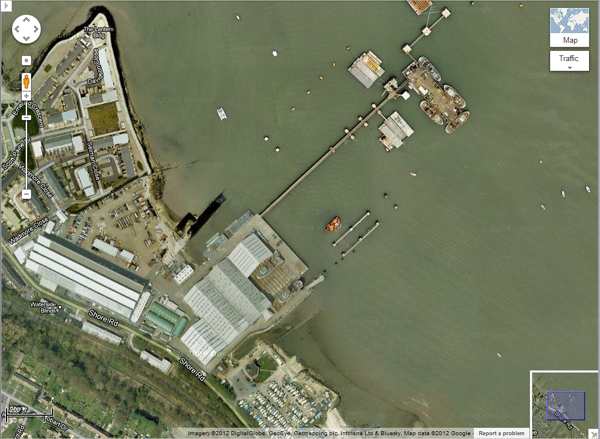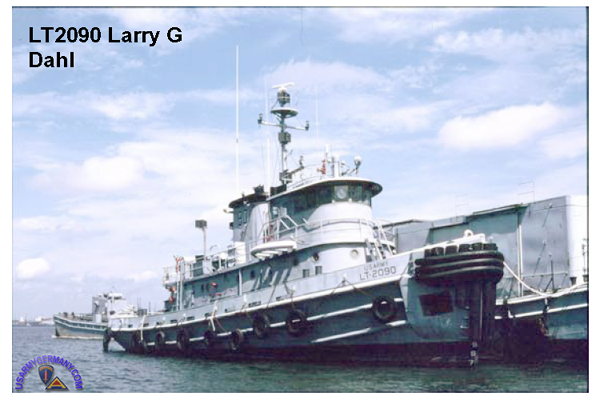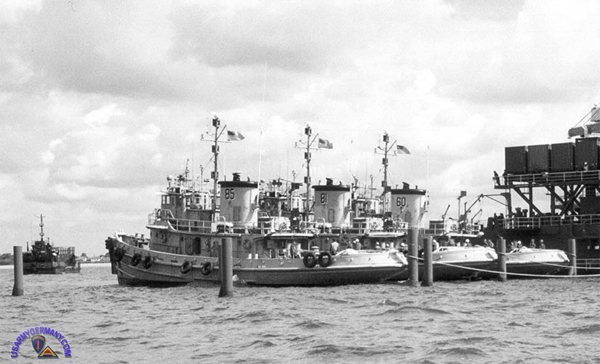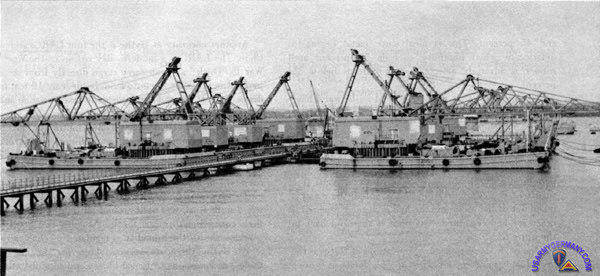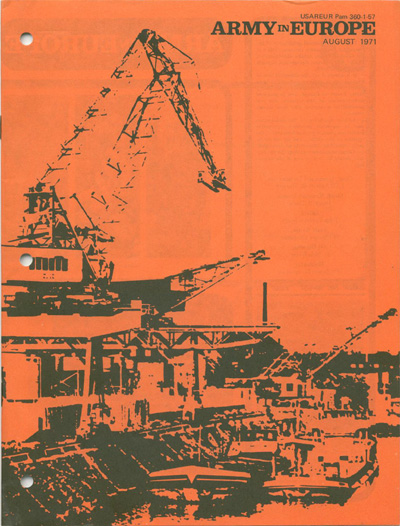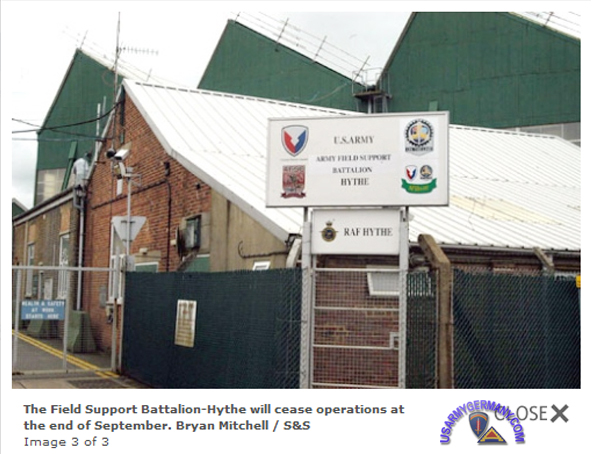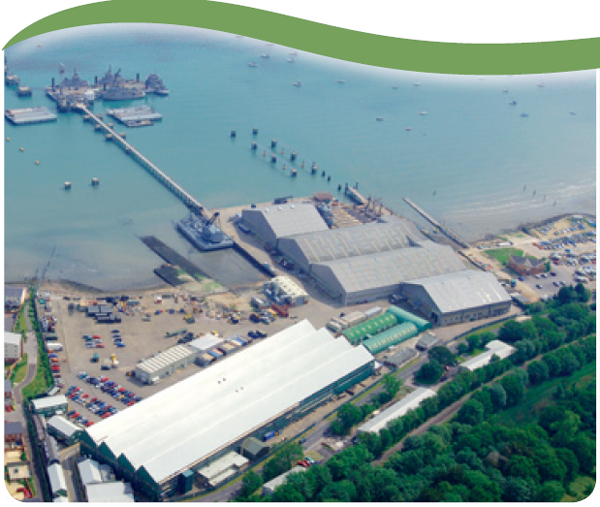| If you do
NOT see the Table of Contents frame to the left of this page, then
Click here to open 'USArmyGermany' frameset |
||||||||||||
|
USAREUR Marine Reserve Fleet |
||||||||||||
|
|
||||||||||||
|
||||||||||||
|
|
||||||||||||
| USAREUR Marine Reserve Fleet | ||||||||||||
| 1955 | ||||||||||||
|
||||||||||||
| 1956 | ||||||||||||
| (Source: USAREUR Annual Historical Report, 1956-57) | ||||||||||||
| The USAREUR Floating Equipment Reserve (Chapter 8, Section V) | ||||||||||||
|
||||||||||||
| Approximately 100 of the required 242 vessels were to be stored in wet storage areas. (2) During the previously mentioned revision of the special theater reserves, Transportation Corps representatives on the Department of the Army Logistics Team recommended that the number of items in the floating equipment reserve be increased by including a new factor -- normal combat attrition rates -- in the computation of items to be stored. By 30 June 1957 USACOMZEUR was revising its storage requirements accordingly. (3) As of 30 June 1957, 206 of the required 242 craft were in the command (Table 1), with the balance scheduled to be shipped during the first quarter of FY 1958. (4) (1) USAREUR Ann Hist Rept, FY 56, pp. 243-47, 266-71. SECRET (2) Ltr, BASEC, USACOMZEUR, to CINCUSAREUR, 23 May 57, sub: Proposed Marine Craft Disposition. SECRET. In Trans Div Mat Br files, E-17 (sites of Eqp) (1957). (3) (A). Ltr, Hq Trans & Maint Comd, to USAREUR Trans Off, 19 Feb 57. SECRET. In file above, E-8 (1957). (B) Interv, Mr. Moenk, with Maj T. F. Begley, USAREUR Trans Div Mat Br, 17 Oct 57. SECRET. (4) (A) Cable DA-919891, DA from DCOFS LOG/C2 to CINCUSAREUR, 22 Mar 57. SECRET. (B) Cable SX-2627, USAREUR from Trans Off to DA for DCOFS LOG/C2, 5 Apr 57. SECRET. (C) Cable DA-920872, DA from DCOFS LOG/C2 to CHOSA ARTERM, Bklyn, 9 Apr 57. SECRET. All in file above. |
||||||||||||
| 1957 | ||||||||||||
| (Source: USAREUR Annual Historical Report, 1957-58) | ||||||||||||
| The USAREUR Floating Equipment Reserve (Chapter 7, Section VI) The USAREUR Floating Equipment Reserve consisted of all vessels, harbor craft, and marine equipment contained in the bills of materials for the numbered sections of USAREUR Theater Reserve Number 1, plus the marine items stocked in accordance with Department of the Army instructions for post D-day logistical support. Except for necessary storage and preservation measures, the reserve vessels were maintained in a state of full readiness. Since a number of similar craft were in active use in the port areas, restrictions on use of substitute reserve items were even more specific than those pertaining to other items in the theater reserves. Specifically prohibited were the activation of stored craft, the interchange of reserve and active craft, the cannibalization of component parts, and the issue of reserve spare parts to meet current operational requirements. (1) The authorized floating marine reserve had remained unchanged since late FY 1957, when USACOMZEUR had revised its storage plan. As of 30 June 1958 a total of 231 of the authorized 242 craft were on hand; still short were eight 65-foot diesel harbor tugs, two 120-foot deck-cargo barges, and one LCM 6. (2) According to the plan proposed at the end of FY 1958, 218 craft were to be stored at 5 locations, at Nantes -- in 2 separate areas, La Rochelle, Rochefort, and Bordeaux. Altogether 107 of these craft were to be stored in wet storage areas. (3) (1) Ltr, USAREUR to USACOMZEUR, 8 Jul 58, subj: Transportation Floating Marine Equipment (U). AEATC-MAT 250/18 TC. UNCLAS. (2) USAREUR Trans Div, Status Rept, Trans Corps Items, Thtr Res Nr 1, 30 Jun 58. SECRET. In Trans Div Mat Br. (3) USAREUR Trans Div, Proposed Marine Craft Dspo Rept, 30 Jun 58. SECRET. In file above, 250/18 R-Sec 29 (1958). |
||||||||||||
| RAF Hythe, Britain | ||||||||||||
| 1967 | ||||||||||||
| (Source: Pittsburgh Post-Gazette, Jan 13, 1967) | ||||||||||||
| An armada of nearly 100 US military ships will begin moving this month (January) from bases in France to the ports of Poole and Hythe on England's south coast. Landing craft, barges, tugs and floating cranes that make up the US Army floating equipment reserve are coming to England in the shuffle caused by President Charles de Gaulle's expulsion of NATO units from France. The British Defense Minister announced that the ships will begin arriving on Jan 19 and the move will be completed by early March. |
||||||||||||
| (Source: http://hansard.millbanksystems.com) An inquiry in the House of Commons revealed the following considerations taken re Poole as a storage site: HC Deb 15 March 1967 vol 743 c114W Portland Harbour (U.S. Army) Mr. Evelyn King asked the Secretary of State for Defence why the United States Army Floating Equipment Reserve was not advised to use Portland Harbour instead of Poole, in the light of the employment it would have provided in Portland. Mr. Foley Portland was one of the fifteen possible sites suggested to the United States Army, but from their point of view it had some disadvantages: there was a shortage of suitable space and buildings for storage ashore and of hard-standings or slipways; there was also a lack of the skilled and unskilled workers required for ship repair; for this type of craft the harbour was not sufficiently protected from the weather and there were the competing requirements of other commercial projects. |
||||||||||||
| 1970 | ||||||||||||
| (Source: STARS & STRIPES, June 13, 1970) | ||||||||||||
| US Army in Europe has more than $3 million worth in vessels on active duty at Bremerhaven, Berlin, Worms (all in Germany) and Leghorn, Italy. And the command also has more than 100 (reserve) vessels stored in England, most of them in "dry" storage. The reserve vessels are stored at Hythe and in smaller warehouses at Poole and Marchwood. The US Army Marine Fleet Activity, with headquarters at Burtonwood, stores and keeps in good operating shape anything from tugboats and barges to floating derricks, landing craft and bridge erection boats. The article goes on to explain that the activity even stores a LARC (Lighter Amphibious Resully Cargo). The author is probably referring to a LARC-LX, better known as a BARC (Barge Amphibious Resupply Cargo). Personnel of the activity are currently involved in a three-year renovation project that involves shaping up and then preserving in a coccon the fleet's more than a dozen tugboats which range from 45 to 100 feet in length. The renovation and wrapping of one 65-foot tub is estimated to cost about $25,000. A mothballed tug can be made fuly operable and ready for action within three days. |
||||||||||||
| (1) Black Jack is a quarterly magazine published by the Southampton Branch of the "World Ship Society" - website. The September 2006 issue of Black Jack includes an article on the Combat Equipment Base - North Atlantic located at RAF Hythe and some photos of various US Army vessels located at the pre-positioned site. (2) The ARMY LOGISTICIAN article desribes a large maritime and LOTS-exercise at RAF Hythe (at that time Combat Equipment Base-North Atlantic) that tests the deployment of equipment kept in pre-positioned maritime storage. |
||||||||||||
| 1971 | ||||||||||||
| 1980 | ||||||||||||
| (Source: STARS & STRIPES, March 29, 1980) | ||||||||||||
| The US Army Marine Fleet Activity (USAMFA) at Hythe, England (1) consist of two sergeants, three Department of the Army civilians and about 100 Brititish boat craftsmen. One of the sergeants, SSgt Dan Strauss, is the chief of activity support. The other, Sgt Larry W. Atkins, is the property book NCO. The mission of USAFMA is to store, maintain and issue marine equipment and related items assigned to the USAREUR marine fleet. Vessels are brought to Hythe from all parts of Europe for major repair and rebuilding. The USAREUR marine fleet consists of harbor operations in England, Germany, Italy and the Azores. The fleet consists of: Although most of the vessels are in "ready to use" condition, only one - a 45-foot tugboat - is active. It is used for routine harbor operations and to transport maintenance inspectors and technicians to vessels in "wet" storage. At the end of the activity's 300-foot pier is moored a floating machine shop. The well-equipped workshop - a seagoing barge - can be towed anywhere and is designed to support a crew which can replace or manufacture almost any part required to repair a sea craft. The machine shop, along with other barges, the 60- and 100-ton cranes, and the 100-foot tugboats are stored in the water ("wet" storage). Smaller vessels, such as the 45- and 65-foot tugs and LARCs are stored in drydock under cover. (Most of the tugboats in drydock have neem mothballed by having shelters built over the pilot's cabin. The LARCs are housed in a large wood-framed structure covered with plastic.) All vessels undergo scheduled maintenance checks. Boats left moored in the harbor have numbers and lines painted near the waterline. This helps workers detect if vessels are taking on water or floating improperly. Divers periodically check the bottom of craft for deterioration. British carpenters, shipbuilders, surveyors, electricians and mechanics overhaul the Army's vessels. (1) Hythe is across the harbor from Southampton and is about 250 miles from its next higher headquarters, Burtonwood Army Depot, near Liverpool. |
||||||||||||
| 1984 | ||||||||||||
| (Source: SUPPORT SENTINEL, July 31, 1984) | ||||||||||||
| Hythe unit puts barge in tow to CONUS by Ian Sinclair (1) |
||||||||||||
| The US Army Reserve Storage Activity in Hythe (RSAH), England, has shipped its BPL 6810 back to the 7th Transportation Terminal Group at Fort Eustis, Va. for use in training. The BPL is a barge 300 feet long by 80 feet wide and 13 feet deep displacing about 2,500 short tons -- also known as a Delong pier. What's unique about this barge is it's a decapod -- a platform with 10 legs which raise it above water to create an instant wharf or jetty for ships to moor at while working their cargo. What's unusual about the BPL 6810's departure from the water off Southampton is that riggers at Hythe had to spend two weeks readying the barge by hand for towing. Call Comes It was a quiet Monday morning at the Reserve Storage Activity when the call came to prepare the BPL for its move to CONUS. Since its size required that it be kept in a storage configuration off shore, the workers immediately began sealing all its watertight compartments, rigging navigation lights and preparing the towing bridle. The bridle consisted of two 90-foot long legs of 2½-inch stud link chain, each leg weighing 2¼ tons. A subsequent phone call informed RSAH that the tug, the USNS Powhatan, would dock at Southampton to pick up the barge on Thursday morning for towing across the Atlantic. That would have presented no problem but, since there was no mechanical equipment out in the river, all the equipment had to be moved by hand. When the Pohatan's captain and his officers arrived to inspect the tow, they caught the Hythe riggers off guard with the news that the tug didn't have any towing equipment. Since RSAH had no equipment either for the tow, a 200-foot 2½-inch stud link chain had to be procured from Wales for a pennant on the towing bridle, as well as a 1,000-foot wire rope from the North of England for an auxiliary towing bridle. In addition, 55-ton safe working load shackles for the auxiliary bridle were purchased locally. It took six days for the equipment to reach Hythe. Tight wire job The riggers spent four days stringing 37 wires together into the auxiliary bridle, which required eyes (loop) with thimbles pliced into them and an eye without a thimble on each end for the pennant. The entire project was done by hand on an improvised bench. After the 5½-ton pennant arrived, the men had to transport it by barge out to the BPL 6810, off-load it and spread it out on the deck. By Sunday morning, preparations for the tow were complete except for the final welding of steel bars across the bit to prevent the bridles from jumping off. After releasing the mooring chains and wires from the cable at Hythe, the men boarded four tugboats to tow the barge down the river to the Hound Buoy to rendezvous with the Powhatan. Once the Powhatan crew had connected the main tow, the RSAH riggers attached the auxiliary bridle, boarded a tugboat and watched with a sigh of relief as the tug and the barge disappeared down river. The trip across the Atlantic was expected to take about 21 days at an average speed of 7.8 knots. (1) Mr. Sinclair is the maintenance chief at RSAH. |
||||||||||||
| 1985 | ||||||||||||
| (Source: SUPPORT SENTINEL, Sept 10, 1985) | ||||||||||||
| Hythe vessels piggyback to US port by MSgt William Thomas Kelly |
||||||||||||
| Part of the Army's Navy -- four 100-foot tugs, two 100-foot floating cranes and two LCM-8 landing craft maintained by the 21st Support Command for more than a decade -- were floated aboard a semi-submersible ship here Aug. 15 during a project that had been under way since February. A Norvegian contractor lowered the Ferncarrier, a converted oil tanker based in Oslo, 16 feet under water to enable the tugs and other vessels to be pulled over the ship's main deck and tied to the bridge and forecastle. Then, the deck was raised to the surface so the smaller craft could be further secured to the deck. According to Capt Keith L. Zimmerman, commander of the 47th ASG's RSA Hythe, the Ferncarrier is under an 18-month lease to the US Army, with another 18-month option. The ship will travel to a US port to meet with another craft to complete the project. "The advantage of using the semi-submersible is its versatility," Zimmerman said. "The 'float-on, float-off' concept enables cargo to be loaded and unloaded without having to go into a pier mooring. The Army selected RSA Hythe for the first-time "float-on, float-off" project because it has the only US pre-positioned stock of watercraft on this side of the Atlantic Ocean, including those required for the project. In preparation for loading of the semi-submersible ship, the tugs were brought out of dry storage and put into operation. TALS -- an acronym for "the auxiliary lighter ship -- is a project to deck-load harbor craft aboard a large, specially designed ship for transportation back into service. Prior to being onloaded, the craft were removed from storage, activated and tested in the Southampton Waters that separate Hythe from Southampton. The hulls were grit-blasted to bare metal before workmen applied five coats of protective paint. After the sea trials, the vessels were preserved. After shipment, they will become part of a rapid deployment unit in a project known as HELPS, an acronym for "heavy equipment lighterage pre-prositioned ship," according to Ian Sinclair, chief of RSA Hythe's maintennace division. "This is a very good challenge for us," Zimmerman said. "We have an all civilian work force and the project required a lot of flexibility, effort and hard work." (Click here to read about the semi-submersible float-on, float-off ship American Cormorant, the name given to the Ferncarrier after it was reflagged as a US ship and acquired by the Military Sealift Command in 1985.) |
||||||||||||
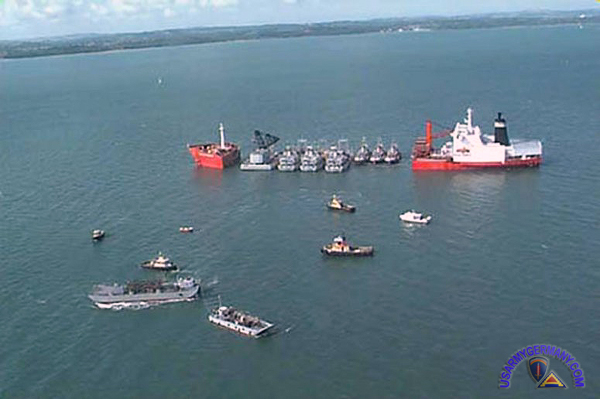 A semi-submersed American Cormorant during offloading operations (Global Security website) |
||||||||||||
| 2006 | ||||||||||||
| (Source: DoD News Release No. 412-06, May 09, 2006) | ||||||||||||
| DoD Announces Installation Realignment in United Kingdom
The Department of Defense announced today that the United States military would cease operations at the Army Prepositioned Site (APS) in Hythe, United Kingdom. Due to U.S. European Command force structure realignment and transformation, and the attendant reduction in storage requirements that has occurred during the past several years, the U.S. Army storage facility at Hythe has been identified as excess to the Army’s needs and will begin the process to be returned to the host nation. Consequently, U.S. operations at APS Hythe will cease by the end of September 2006. This action is expected to save $15.2 million annually, and will affect one U.S. service member, one U.S. DoD civilian employee and 210 host nation employees. As with all stationing actions, the United States has coordinated with host nation officials before this announcement. |
||||||||||||
| Related Links: | ||||||||||||
|
||||||||||||

